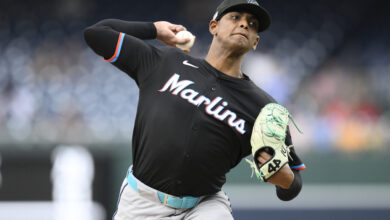
Keegan Thompson Becoming Workhorse After Trip to Glute Factory
Even at this early point in the season and with pitcher usage changing rapidly, it’s a little odd to see a reliever leading his team in fWAR and wins while tallying the second-most innings. Those numbers will shift rapidly as the season moves along, but Keegan Thompson‘s 0.5 fWAR following Friday’s four-inning performance is better than the rest of the Cubs’ pitching staff combined (0.2).
The 27-year-old righty has become a surprise star out of the bullpen due to the ability to provide backup length to a rotation that has largely been unable to go deep into games. Friday’s outing was his longest, but even his previous efforts of 2.2, 3.1, and 3.2 innings match the output of various starters at different points this year. Bulk alone isn’t enough, of course, which is where Thompson’s 0.00 ERA comes in handy.
He’s struck out 14 over 13.2 innings, but what’s most impressive is the pairing of a 6.4% walk rate with a 62.1% grounder rate. Hitters simply haven’t been able to square Thompson up as he works his fastball/cutter/curve combo with impeccable command, as evidenced by a -1.3 degree launch angle allowed that ranks fifth in MLB right now.
The Cubs were expected to go out and find power pitchers capable of missing bats, an endeavor that appeared to have been abandoned even before the lockout shut things down in December. Thompson doesn’t really fit that description because his mid-90s fastball isn’t exactly overpowering by today’s standards and his 11.9% swinging-strike rate is barely above the 11.3% league average, so it’s not as though Jed Hoyer just opted for a homegrown path.
What Thompson offers, however, is a hybrid approach that blends aspects of power and finesse to make him the kind of long man today’s bullpens need. Unlike so many other stories from the Cubs’ arm barn, it wasn’t a matter of finding a new pitch grip or overhauling his pitching mechanics. As Sahadev Sharma chronicled for The Athletic, Thompson’s improvement was as simple as getting stronger in his lower half.
“He’s always been a guy, especially out of the windup, with a high swing-up leg kick,” pitching coach Tommy Hottovy explained. “When that happens, if he’s not stable on that back leg, then he swings it up and when he gets to that high point, he has to reorganize on the way down. It takes a lot of effort to do that. Any point in your delivery that takes effort, it usually costs you velocity or stuff.
“The more engaged (his back leg is), the more controlled that leg lift is. The less engaged your back leg is, you’re lifting from your front hip instead of being engaged in your back glute and being able to lift your leg.”
Okay, it’s actually a bit more involved than just getting stronger, and I’d encourage you to read more about how the Cubs were able to identify and correct the flaw in Thompson’s mechanics. The result is a stronger pitcher whose stuff is playing much better through smoother, more repeatable mechanics. That leads to Thompson being more confident, which just continues to feed the process.
There was talk during Friday’s broadcast of him potentially joining the rotation at some point, but that feels to me like a case of trying to fix what ain’t broken. With Wade Miley approaching a return from elbow inflammation and Caleb Kilian getting closer to a call-up all the time, there will be more than enough pitchers for the rotation. Having a guy like Thompson who has reveled in a long role that frequently involves high-leverage innings isn’t nearly as easy to find.
Barring a sudden change in either performance or philosophy, we’re not going to see David Ross letting his starters go deep into games with any sort of high frequency. That makes Thompson and pitchers of his ilk even more valuable. Now the Cubs just need to start scoring some more runs so that Thompson can preserve a lead rather than giving his offense a prolonged opportunity to come back.

